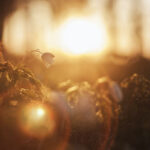If you’re looking for a great off-camera flash tutorial, look no further. Whether you use a mirrorless camera or not, photographer Joe Brady will give you a run down on everything strobe related: single flash, multiple flash, light meters, camera settings for flash, high-key lighting, low-key lighting, you name it. Not only does Brady concisely explain everything while using a model and strobes to give you a clear visual, but between each of his mini-tutorial shoots he also does a Q&A session. This helps answer a lot of questions about the gear, settings, and reasons for the techniques:
Lighting Tools That Can Add to Your Images
- Reflector. A reflector is a great tool for using with either natural or artificial light. Whether you use it to bounce light and highlight your subject or just to fill in shadows, a reflector can be a great low-cost investment. They also come in many different colors and finishes that affect the color and amount of light they reflect.
- Light Meter. A light meter is not necessary for using strobes, but it can take out some of the guesswork. They may seem a bit complicated at first, but once you understand how they work they can make your shooting much more efficient.
- Umbrella. Umbrellas help spread light over your subject and create a much softer, reflected light.
- Gels. These little pieces of plastic come in a variety of colors, allowing you to create warmer or cooler tones in your images, or create dramatic colored highlights.
- Snoot. There are many attachments that you can add to your flash to affect the light it produces. One of these is called a snoot which is a long cylindrical or rectangular tube that allows you to create a spot of light and reduce the amount of light spillage.

Brady explains how to create high-key lighting
Background is another important element to keep in mind when shooting with strobes. Some factors that you should consider when choosing a background are the texture, color, whether you’ll be lighting the background, and how well your subject will be separated from the background.
Like This Article?
Don't Miss The Next One!
Join over 100,000 photographers of all experience levels who receive our free photography tips and articles to stay current:






A light meter is certainly not essential for off camera flash.
It’s handy of course but to honest if you are starting out and have an understanding subject I’d start off without one.
Your article is wrong. A light meter is absolutely necessary. You even talk about it in the video!